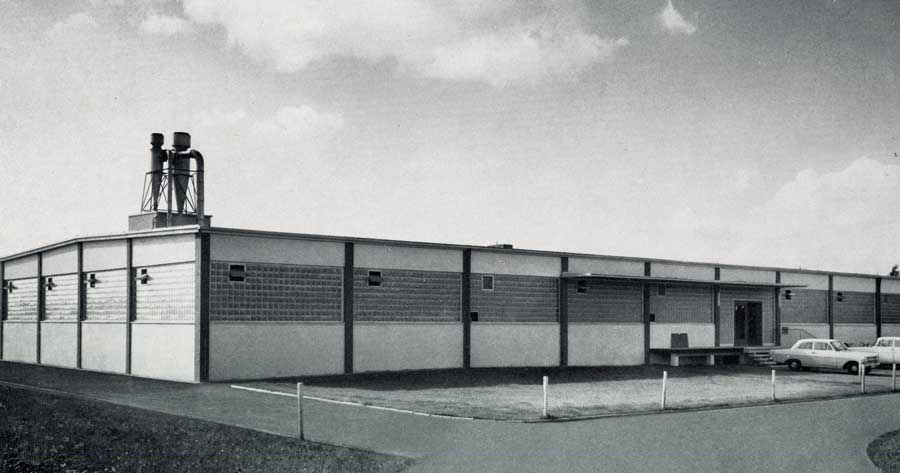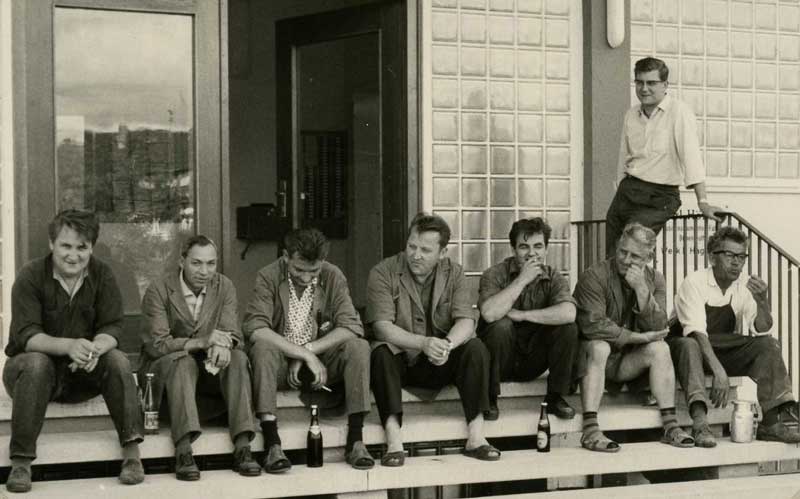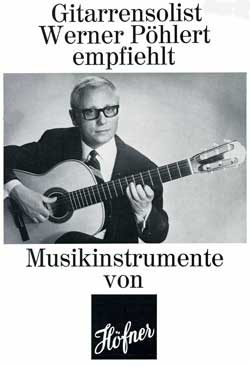

The newly completed Hӧfner workshops at Hagenau - 1965
The late 1950s and first half of the 1960s were
years in which Hӧfner, and many other guitar manufacturers could do no wrong.
Demand for their products had increased steadily throughout the 1950s, but from
around 1961 onwards it soared due to the impact of four and five-piece rock
bands appearing on every street corner throughout the UK and perhaps to a lesser
extent, Europe. The Bubenreuth workshops were subjected to a fourth phase of
building work in 1959, just three years after the previous extension in 1956,
and still Hӧfner lacked the workspace to meet demand.
The site at Bubenreuth was now full, and so
Walter and Josef considered other options. There was a courtyard in the center
of the workshops that remained available, and so plans were drawn up in 1963 to
investigate filling that last area with a double story building. However, no
matter how hard they tried, this still would not provide sufficient space. At
last, it was decided instead to set up a satellite workshop building at nearby Hagenau, a residential “new” village located 5Km North East of Bubenreuth. This
would be used for the first stage machining of timber and assembly of guitar
bodies which would then be finally assembled and finished at Bubenreuth. The new
Hagenau facility was duly opened in 1964.
And it wasn’t all just about more bricks and
mortar. Also during this period in 1963, a young professional engineer called
Christian Benker joined the Hӧfner company. Christian and his wife to be,
Gerhilde Hӧfner, would soon have to take over the running of the company and
guide it through much more difficult times.

As explained previously, the second half of the
1950s saw a steady change in the popular music and dance scene. Jazz and big
band dance music was slowly being replaced by the much more basic and cheaper to
stage skiffle and rock n roll as the music to which the vast majority of people
danced to. Guitars which relied entirely on their acoustic properties were just
not loud enough for these new styles of music. So, electric versions of the
archtop models steadily took over from fully acoustic for playing “live” music,
with acoustic versions still continuing on a reduced scale for use in the home.
There is a case to be made that, if one plays an
archtop entirely by amplifying it using electrical pickups, then the full
acoustic properties of its usually bulbous body are not entirely necessary.
Under those circumstances, perhaps the body can be reduced in size at the
expense of its acoustic properties and hence be made more comfortable to play.
As further benefits, the possibility of feedback would then be reduced to some
degree, and maybe the looks of the guitar might even be improved but hey, we are
now treading on really dangerous ground!
Gibson were obviously
thinking along such lines when, in 1955, their 225T model was introduced.
Gretsch were by then also producing thinline electric archtop guitars, but as
all new designs rather than modified versions of acoustic guitars. As we have
seen from the previous chapter, Hӧfner finally followed this trend in 1959,
initially making 2” deep bodied versions of certain Selmer London-distributed
guitars, i.e. the Senator, President, and Committee, and followed a few months
later by the thinline version of the Golden Hofner. The fact that it was the
Selmer models that first received this treatment once again points to the
probability that it was actually Ben Davies who had again spotted the trend and
requested this feature for the Selmer guitars. As with other innovative requests
from Selmer however, Walter began to offer the feature on some of his general
market models during the following year, 1960.
We should now mention however that this was not
the first time that Walter had taken a full depth archtop body and cut down the
sides a little. He did that in 1957 when he designed the 500/5 bass guitar by
using the 4550 archtop model’s body, but with shallower 2½” deep body sides. He
then went on to offer a 2 ½” deep body on the 4570/S/ guitars introduced in
1958.
As stated above, Hӧfner’s first general market thinline offering
was based on the cutaway bodied, electric versions of the mid-range 457 archtop.
The product designation of Hӧfner Thinlines from then onwards was arrived at by
simply adding a zero to those of their full-bodied siblings, and so the 4570
came into being in 1958. Either one (E1) or two (E2) pickups were available for this
model, together with the further option of an active boost (T1 or T2). For around the first
3 or 4 years of the 4570’s production life, it had a 60mm (2 ½”) deep body and
those guitars which were not finished in natural blonde were given a very
attractive red sunburst to the front and back of the body, with black lacquered
rim and neck. The body size finally reverted to 50mm in line with the later archtop thinlines in the early 1960’s, at which time the beautiful red sunburst
was generally replaced by Hӧfner’s standard tobacco brown sunburst.
The added zero
designation of Hӧfner Thinlines
would appear at first thought to be a good idea. However, there is scope for
confusion as Hӧfner already
had a 4550 model, and this was a full-depth bodied archtop. As it happens, Hӧfner
never did produce a thinline version of the 455 model which does help a little.
Even so, Hӧfner students beware, particularly as a few of Hӧfner’s true
semi-acoustic guitars were also later given designation numbers that began with
a full-bodies archtop designation and ended with a zero – i.e. the 4580 and 4600
semis.
An unusual guitar was later developed by Hӧfner
using the 4570 as the basis for an electric 12-string archtop. This appeared in
1966 and was produced for about four years or so with the catalogue designation
of 457-12. A few of these instruments were also provided to Selmer London and
sold as the “Hӧfner President 12-String” model. Even the “Gagliano” trade-name
was given to a very small number, which proves that the radical electric archtop
12-string trail-blazed itself all the way to the US.
Around 1959/60, a 50mm (2”) deep bodied version
of the 456/S became available. The thinline 4680 appeared in the 1961 catalogue
as a 50mm bodied 468 model, with the 4500 based on the budget-level 450
following a little later in 1965. Finally, the beautiful 4700 arrived in 1966,
completing a thinline range based on Hӧfner’s old traditional archtop models,
the 450, 456, 457, 468, and 470. This seems to have generally followed the range
of thinlines produced for Selmer London, i.e. the Senator, President, Committee,
and Golden Thinlines.
Following on from the
above thinline versions of traditional archtops, twin cutaway archtop models
still with fully hollow bodies were introduced such as the Hofner Ambassador as
described in the previous chapter. We have already described how that model
faded away in 1968 due to poor sales in the UK. However, by then Hӧfner were
making virtually the same guitar for their general worldwide market and this was
designated as the 4578 model. This proved to be quite a successful guitar,
despite the UK’s lack of interest, particularly in the US where it featured in
the Sorkin/Multivox catalogues
for many years. All the Hӧfner guitars were available from around 1967 with the
Walter’s latest active electrics and their distinctive moon-shaped control
consoles which he had developed in conjunction with the Franz Pix Company.
However, the 4578 model in particular was equipped with such options as Treble
Boost, Fuzz Tone, Sound Mix, and even Wah-Wah which was controlled by the use of
a small lever located on the guitar’s pickguard.
Hӧfner guitars were by the 1960’s being sold
almost all over Europe, as well as most of the rest of the World. However, Spain
was one European country where there was a problem: crippling import taxes
prevented German-made guitars from being sold there at a competitive price.
It so happened that at the end of 1944, a company
called Keller had been set up in Northern Spain by a man called Enrique Keller
Fritsch, who just happened to have been born in Germany. Perhaps Enrique’s
origins proved to be the catalyst for a deal to be struck between his company
and Hӧfner. This was for Hӧfner to supply guitar components to Keller for them
to assemble into Spanish-made guitars, based in the main on existing Hӧfner
models. The import tax problem was solved!
Initially in 1963, Kellers produced a couple of
solid guitar models to their own design using Hӧfner-supplied hardware. These
were very soon followed by Hӧfner Violin and Club basses, capitalising on the
Beatles’ Worldwide success. By 1966, full-bodies and thinline archtops were
being produced by Keller, based on some of the most successful Hӧfner
German-made models such as the 450, 463, 4574, 4600, and even the Club-style
guitars.
Spanish-made/assembled guitars usually have a “Fabricado
En Espana” inscription on the back of their bodies. They are not usually
cosmetically exact copies of their German-equivalents, with bright white
pickguards, control consoles, and indeed rather garish hatched body binding on
some models. They are however, easily recognisable as Hӧfner designs.
Much research still needs to be undertaken on the
history and development of the Keller-Hofners, and it is suspected that to do
true justice to them, much more space than can be afforded in this book will
eventually be necessary. However, the two examples shown here should be
sufficient to ensure that Hӧfner enthusiasts are aware that not every Hӧfner
made in the 1960s originated from Germany.

In 1969, Hӧfner indulged in the marketing of a
range of three already existing guitar models which were endorsed by one of
Germany’s top jazz guitarists, Werner Pӧhlert. These were the 497 model
classical guitar, the 500/8 bass guitar, and the 4578 thinline archtop. The 4578
had the word “Pӧhlert” inscribed on its “Lyre-style” tailpiece. Other than that,
it was a standard 4578 model guitar. This rather blatant marketing exercise
followed on from a more genuine arrangement, recently researched by Alan Cramp
of the Just Jazz Guitars website, whereby Hӧfner had been supplying Werner with
a special electric thinline archtop that he made available to his pupils and
followers. These guitars, dating from around 1963-65, did not have the Hӧfner
name on them; only the word “Pӧhlert” on their Escutcheon tailpieces. They
appear to have been actually based on the Committee thinline model, with large
18” wide bodies, but with a slightly more restrained level of ornamentation.
Twin Type 511 “Staple” pickups were fitted to those examples which have come to
light so far. They really are rare guitars, and worthy to carry the Pӧhlert
name!
Despite the rapid rise of
the thinline, the Company wasn’t totally turning its back on full-bodied
archtops however. There was still a reduced market out there for “Jazz Boxes”,
and over the years Hӧfner had achieved a good reputation for that style of
guitar, which Walter and Josef were not prepared to abandon. After all, this
new-fangled “Beat” music could and probably would soon disappear and then there
may be a return to more traditional music requiring traditional archtops.
However, Hӧfner’s range of archtops had become far too extensive to
handle, particularly now that many thinline, solid, and bass models were also
being produced in order to satisfy the needs of the many music styles prevalent
at the time. So, a steady rationalisation exercise took place throughout the
1960’s. Many of the early archtops were removed from the catalogue, including
the 456 (replaced by the 4560), the 459, the 461, and the 464. Even the 468 had
disappeared by 1969. Hӧfner’s earliest archtop the 455, which had been produced
since the Schönbach days, was discontinued in 1970.
By the end of the decade therefore, the
“traditional Hofner” full bodied archtops had been slimmed down to the 449, the
450, the 457, the 463, and the 470. This still provided a range of models which
covered the full spectrum of purchasers’ budgets, but also allowed the company
the capacity to provide the by now enormously popular thinlines………. and also the
new semi-acoustic arch-topped guitars!
__________________________________________________
All Text is Copyright
© 2022 Steve Russell. All Rights Reserved